Eco-Economic Coordination Analysis of the Yellow River Basin in China: Insights from Major Function-Oriented Zoning
Abstract
:1. Introduction
2. Research Area, Materials, and Methods
2.1. Research Area
2.2. Data Source and Preprocessing
2.3. Research Methods
2.3.1. NPP Change Trend Analysis Method
2.3.2. Ecological Value Evaluation
- 1.
- The Value of Organic Matter
- 2.
- Fixed CO2 Value and Release O2 Value
- 3.
- Ecological Value
2.3.3. Analytic Hierarchy Process
2.3.4. Eco-Economic Coordination Evaluation
3. The Spatio-Temporal Pattern of NPP in the Yellow River Basin
3.1. Temporal and Spatial Distribution Characteristics of Annual Average NPP of Vegetation
3.2. Analysis of the Change Trend inVegetation NPP
4. Evaluation of the Ecological and Economic Coordination Relationship in the Yellow River Basin
4.1. The Dynamic Characteristics of Ecological Value and Economic Value in the Yellow River Basin
4.2. The Spatial Distribution Characteristics of Ecological Value in the Yellow River Basin
4.3. The Spatial Characteristics of the Economic Development Level of the Yellow River Basin
4.4. Degreeof Coordinated Development of an Ecological Economy in the Yellow River Basin
4.4.1. Time-Series Analysis
4.4.2. Analysis of Spatio-Temporal Changes
5. Discussion
5.1. Comparison of NPP Data Accuracy in the Yellow River Basin
5.2. Reliability Verification of Ecological-Economic Coordination Model
5.3. Comparison of Research Results and Related Results
5.4. Recommendationsfor Sustainable Development Policy of the Yellow River Basin Region
6. Conclusions
Author Contributions
Funding
Institutional Review Board Statement
Informed Consent Statement
Data Availability Statement
Acknowledgments
Conflicts of Interest
References
- Harte, M.J. Ecology, sustainability, and environment as capital. Ecol. Econ. 1995, 15, 157–164. [Google Scholar] [CrossRef]
- Pao, H.T.; Chen, H.P.; Li, Y.Y. Competitive dynamics of energy, environment, and economy in the US. Energy 2015, 89, 449–460. [Google Scholar] [CrossRef]
- Ghosh, S.; Kanjilal, K. Long-term equilibrium relationship between urbanization, energy consumption and economic activity: Empirical evidence from India. Energy 2014, 66, 324–331. [Google Scholar] [CrossRef]
- Chen, C.; Sun, Y.; Lan, Q.; Jiang, F. Impacts of industrial agglomeration on pollution and ecological efficiency: A spatial econometric analysis based on a big panel dataset of China’s 259 cities. J. Clean. Prod. 2020, 258, 120721. [Google Scholar] [CrossRef]
- Xu, M.Y.; Chen, C.T.; Deng, X.Y. Systematic analysis of the coordination degree of China’s economy-ecological environment system and its influencing factor. Environ. Sci. Pollut. Res. 2019, 26, 29722–29735. [Google Scholar] [CrossRef]
- Riao, D.; Zhu, X.; Tong, Z.; Zhang, J.; Wang, A. Study on land use/cover change and ecosystem services in Harbin, China. Sustainability 2020, 12, 6076. [Google Scholar] [CrossRef]
- Sun, Y.; Cui, Y. Evaluating the coordinated development of economic, social and environmental benefits of urban public transportation infrastructure: Case study of four Chinese autonomous municipalities. Transp. Policy 2018, 66, 116–126. [Google Scholar] [CrossRef]
- Wang, F.; Gao, C.; Hu, W. The influence of water transportation evolution on the economic development of cities along the Beijing–Hangzhou Grand Canal since the late Qing Dynasty. In Water-Related Urbanization and Locality: Protecting, Planning and Designing Urban Water Environments in a Sustainable Way; Wang, F., Prominski, M., Eds.; Springer Singapore: Singapore, 2020; pp. 27–45. [Google Scholar]
- Zhao, Y.; Wang, S.; Zhou, C. Understanding the relation between urbanization and the eco-environment in China’s Yangtze River Delta using an improved EKC model and coupling analysis. Sci. Total Environ. 2016, 571, 862–875. [Google Scholar] [CrossRef] [PubMed]
- Wang, S.; Ma, H.; Zhao, Y. Exploring the relationship between urbanization and the eco-environment: A case study of Beijing–Tianjin–Hebei region. Ecol. Indic. 2014, 45, 171–183. [Google Scholar] [CrossRef]
- Xie, J.; Ma, Y. Construction of carbon economy index system of Hebei Industry based on the model of DSR. In Proceedings of the 2014 4th International Conference on Education and Education Management, Hangzhou, China, 15–16 April 2017; Lee, G., Ed.; Information Engineering Research Institute: Texas City, TX, USA, 2014; Volume 68, pp. 224–227. [Google Scholar]
- Zhang, D.; Yang, S.K.; Wang, Z.Z.; Yang, C.Y.; Chen, Y.Y. Assessment of ecological environment impact in highway construction activities with improved group AHP-FCE approach in China. Environ. Monit. Assess. 2020, 192, 451. [Google Scholar] [CrossRef]
- Yang, Y.; Cai, Z. Ecological security assessment of the Guanzhong Plain urban agglomeration based on an adapted ecological footprint model. J. Clean. Prod. 2020, 260, 120973. [Google Scholar] [CrossRef]
- Yang, Y.; Bao, W.; Liu, Y. Coupling coordination analysis of rural production-living-ecological space in the Beijing-Tianjin-Hebei region. EcolInd 2020, 117, 106512. [Google Scholar] [CrossRef]
- Han, H.B.; Zhong, Z.Q.; Guo, Y.; Xi, F.; Liu, S.L. Coupling and decoupling effects of agricultural carbon emissions in China and their driving factors. Environ. Sci. Pollut. Res. 2018, 25, 25280–25293. [Google Scholar] [CrossRef] [PubMed]
- Fan, J. Draft of major function oriented zoning of China. Acta Geogr. Sin. 2015, 70, 186–201. [Google Scholar]
- Fan, J. The strategy of major function oriented zoning and the optimization of territorial development patterns. Bull. Chin. Acad. Sci. 2013, 28, 193–206. [Google Scholar]
- Fan, J.; Sun, W.; Zhou, K.; Chen, D. Major Function Oriented Zone: New method of spatial regulation for reshaping regional development pattern in China. Chin. Geogr. Sci. 2012, 22, 196–209. [Google Scholar] [CrossRef]
- Shi, T. Spatial correlation network and regional connected effect of coupling coordination degree between ecological protection and high-quality economic development in the Yellow River regions. Reg. Econ. Rev. 2020, 3, 25–34. [Google Scholar]
- Jin, F.J. Coordinated promotion strategy of ecological protection and high-quality development in the Yellow River Basin. Reform 2019, 11, 33–39. [Google Scholar]
- Xu, Y.; Wang, C.S. Ecological protection and high-quality development in the Yellow River Basin: Framework, path, and countermeasure. Bull. Chin. Acad. Sci. 2020, 35, 875–883. [Google Scholar]
- Giddings, B.; Hopwood, B.; O’Brien, G. Environment, economy and society: Fitting them together into sustainable development. Sustain. Dev. 2002, 10, 187–196. [Google Scholar] [CrossRef]
- Carreño, L.; Frank, F.C.; Viglizzo, E.F. Tradeoffs between economic and ecosystem services in Argentina during 50 years of land-use change. Agric. Ecosyst. Environ. 2012, 154, 68–77. [Google Scholar] [CrossRef]
- Richmond, A.; Kaufmann, R.K.; Myneni, R.B. Valuing ecosystem services: A shadow price for net primary production. Ecol. Econ. 2007, 64, 454–462. [Google Scholar] [CrossRef]
- Qiao, X.N.; Wang, L.F.; Niu, H.P.; Yang, Y.L.; Gu, Y.Y. The eco-economic coordinate analysis of Huaihe River Basin in Henan Province based on NPPdata. Econ. Geogr. 2016, 36, 173–189. [Google Scholar]
- Xu, H.; Shi, N.; Wu, L.L.; Zhang, D.W. High-quality development level and its spatiotemporal changes in the Yellow River Basin. Res. Sci. 2020, 42, 115–126. [Google Scholar] [CrossRef]
- Kong, D.X.; Miao, C.Y.; Wu, J.W.; Borthwick, A.G.L.; Duan, Q.Y.; Zhang, X.M. Environmental impact assessments of the Xiaolangdi Reservoir on the most hyperconcentrated laden river, Yellow River, China. Environ. Sci. Pollut. Res. 2017, 24, 4337–4351. [Google Scholar] [CrossRef] [PubMed]
- Chen, P.F. Monthly NPP Dataset Covering China’s Terrestrial Ecosystems at North of 18°N (1985–2015). J. Glob. Chang. Data Discov. 2019, 3, 34–41. [Google Scholar]
- Chen, P.F. Monthly NPP 1 km Raster Dataset of China’s Terrestrial Ecosystems (1985–2015). Glob. Chang. Res. Data Publ. Repos. 2019, 3, 34–41. [Google Scholar]
- Randerson, J.T.; Masiello, C.A.; Still, C.J.; Rahn, T.; Poorter, H.; Field, C.B. Is carbon within the global terrestrial biosphere becoming more oxidized? Implications for trends in atmospheric O2. Glob. Chang. Biol. 2006, 12, 260–271. [Google Scholar] [CrossRef] [Green Version]
- Zhenshan, W.; Shaoliang, Z.; Xuefei, W.; Yongjun, Y. Evaluation of environmental purification service for urban green space in Nanjing. Nat. Environ. Pollut. Technol. 2015, 14, 1019–1025. [Google Scholar]
- Li, Y.; Li, Y.; Zhou, Y.; Shi, Y.; Zhu, X. Investigation of a coupling model of coordination between urbanization and the environment. J. Environ. Manag. 2012, 98, 127–133. [Google Scholar] [CrossRef]
- Tian, Z.H.; Zhang, D.D.; He, X.H.; Guo, H.L.; Wei, H.T. Spatiotemporal variations in vegetation net primary productivity and their driving factors in Yellow River Basin from 2000 to 2015. Res. Soil Water Conserv. 2019, 26, 255–262. [Google Scholar]
- Zhu, Y.Y. Remote Sensing Estimation of Vegetation Net Primary Productivity in the Yellow River Basin from 1992 to 2015 and Its Response to Climate Change. Ph.D. Thesis, Chang’an University, Xi’an, China, 2019. [Google Scholar]
- Sun, Y.; Ding, W.; Yang, Z.; Yang, G.; Du, J. Measuring China’s regional inclusive green growth. Sci. Total Environ. 2020, 713, 136367. [Google Scholar] [CrossRef] [PubMed]
- Zameer, H.; Yasmeen, H.; Wang, R.; Tao, J.; Malik, M.N. An empirical investigation of the coordinated development of natural resources, financial development and ecological efficiency in China. Resour. Policy 2020, 65, 101580. [Google Scholar] [CrossRef]
- Zhang, G.X.; Su, Z.X. Construction and measurement of high-quality development evaluation system for the central cities in the Yellow River Basin. Ecol. Econ. 2020, 36, 37–43. [Google Scholar]
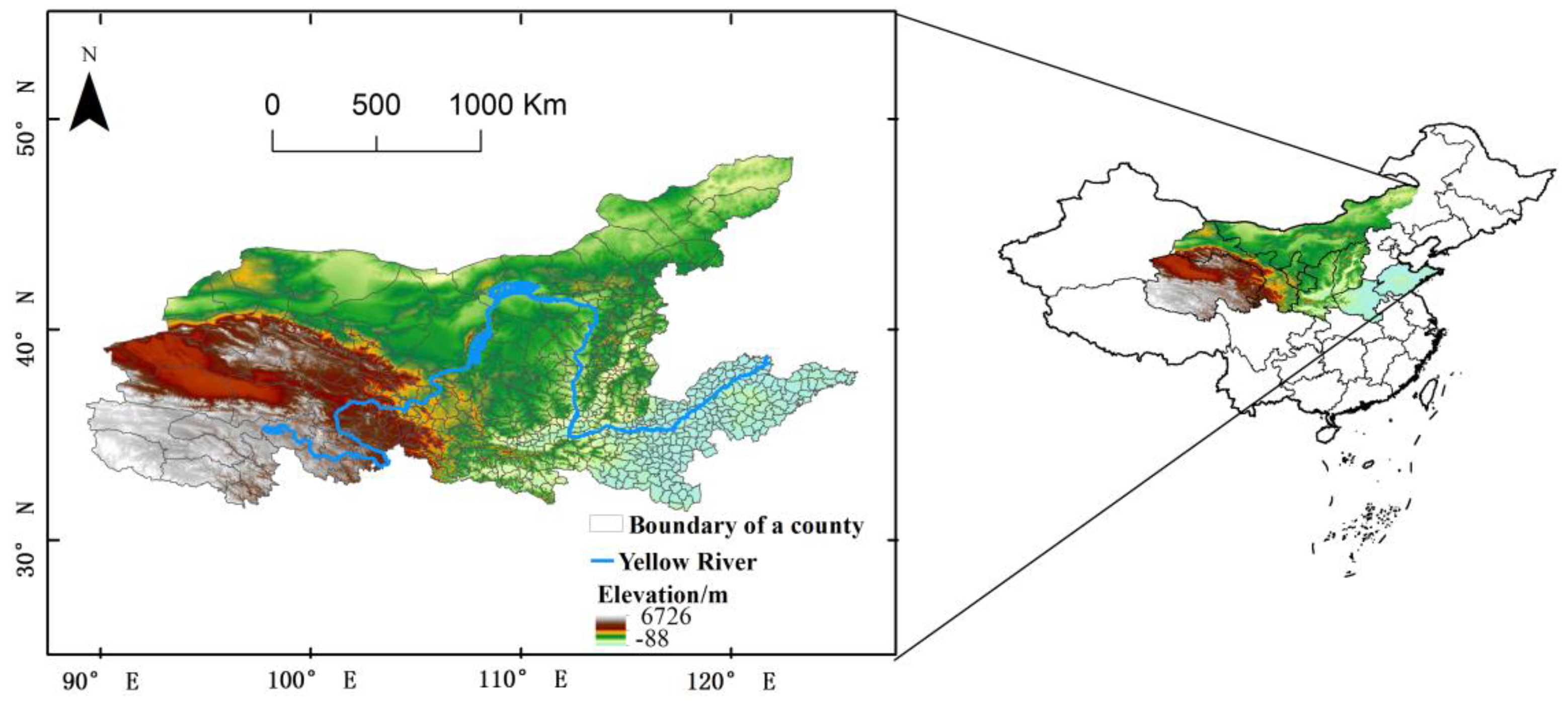

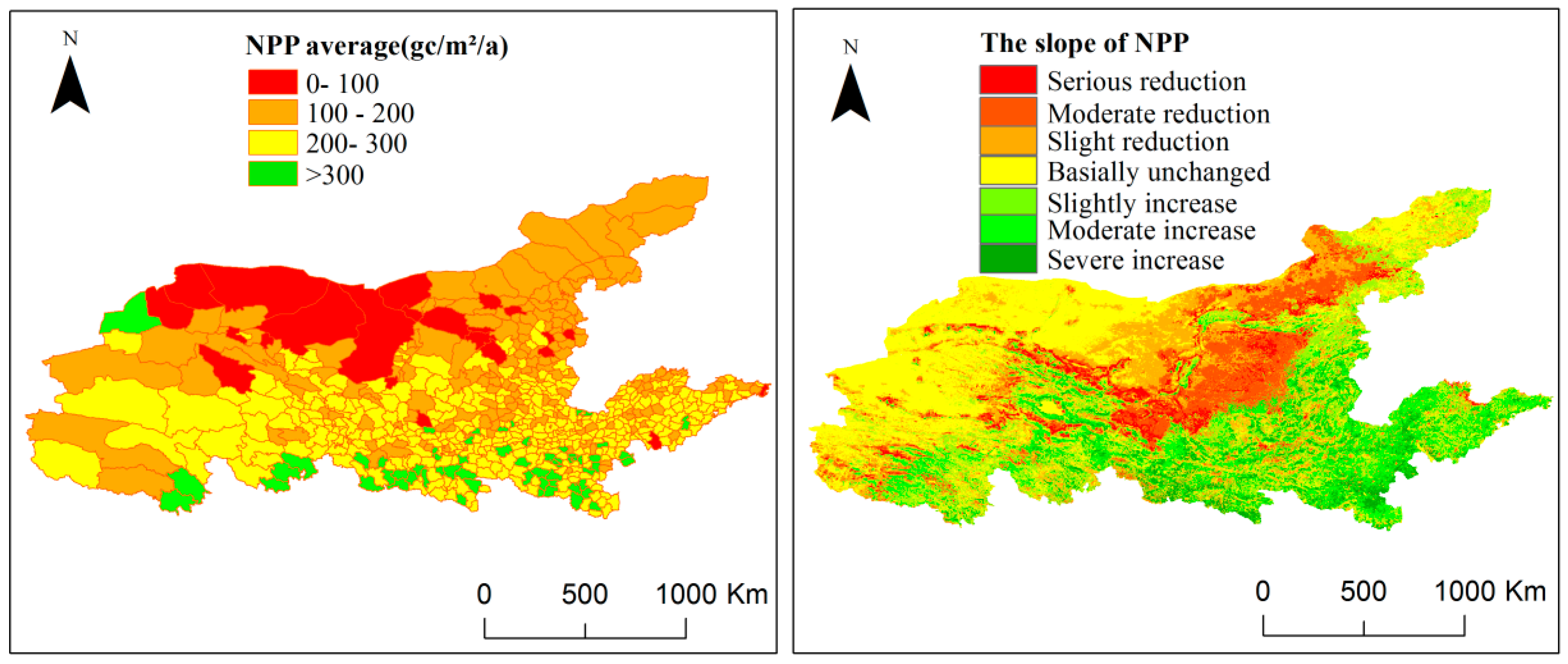
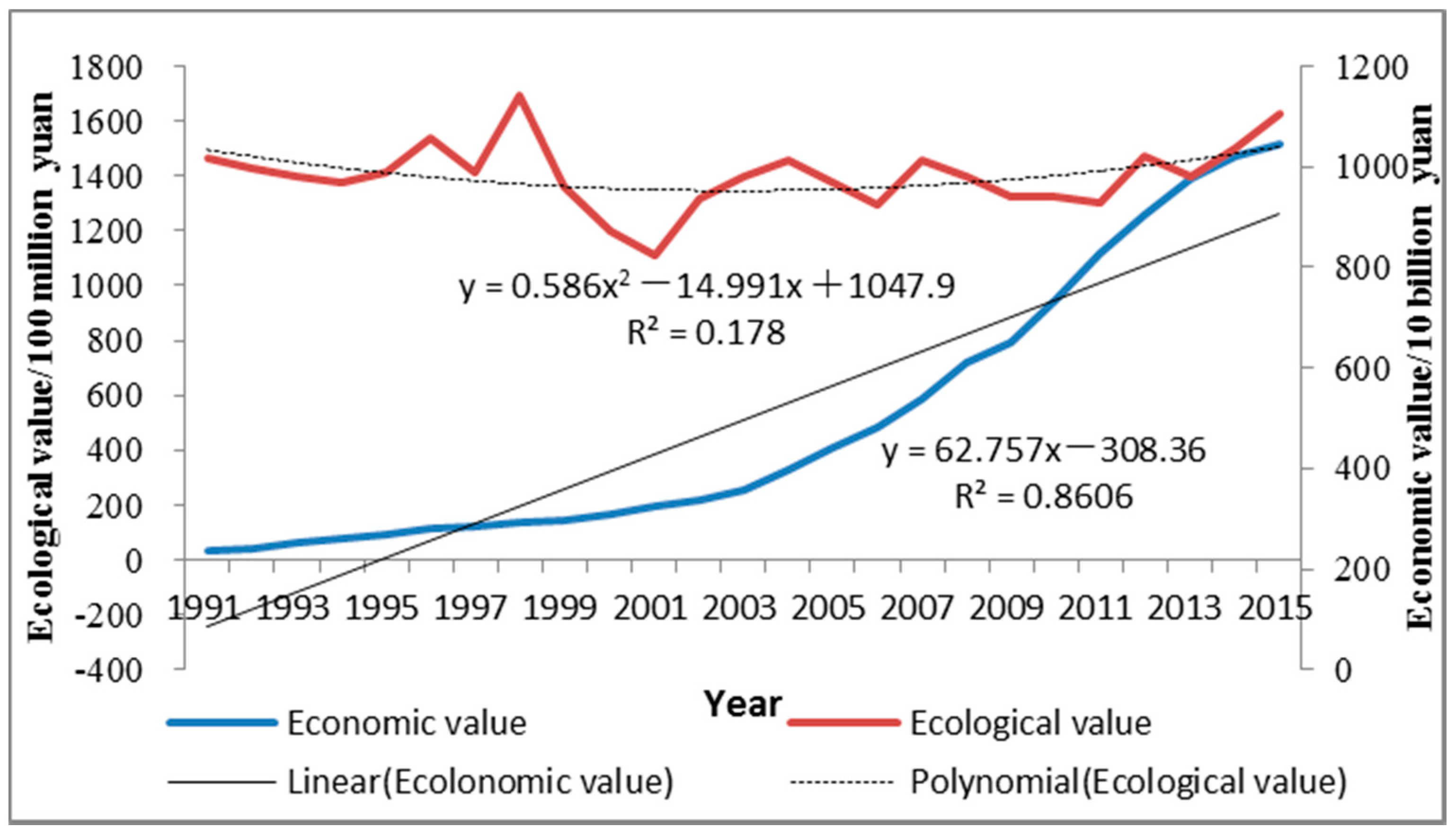
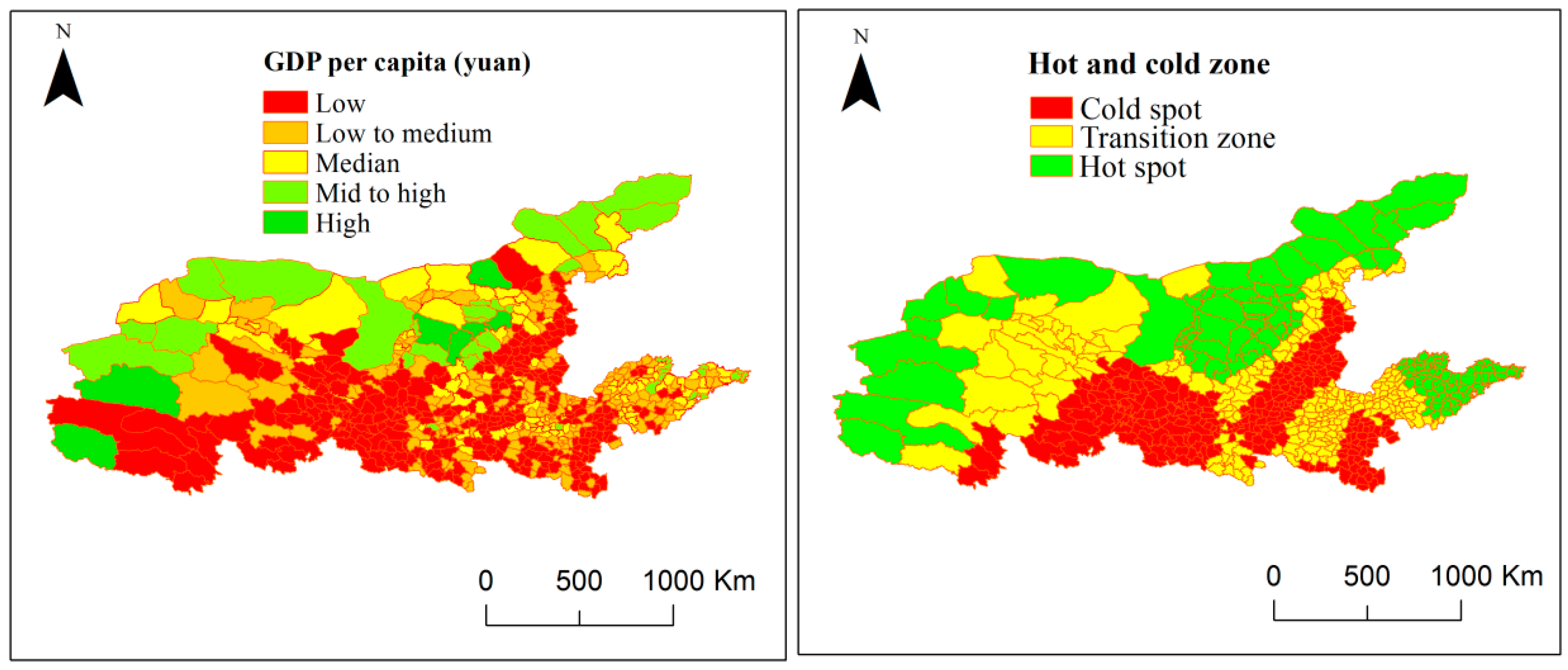

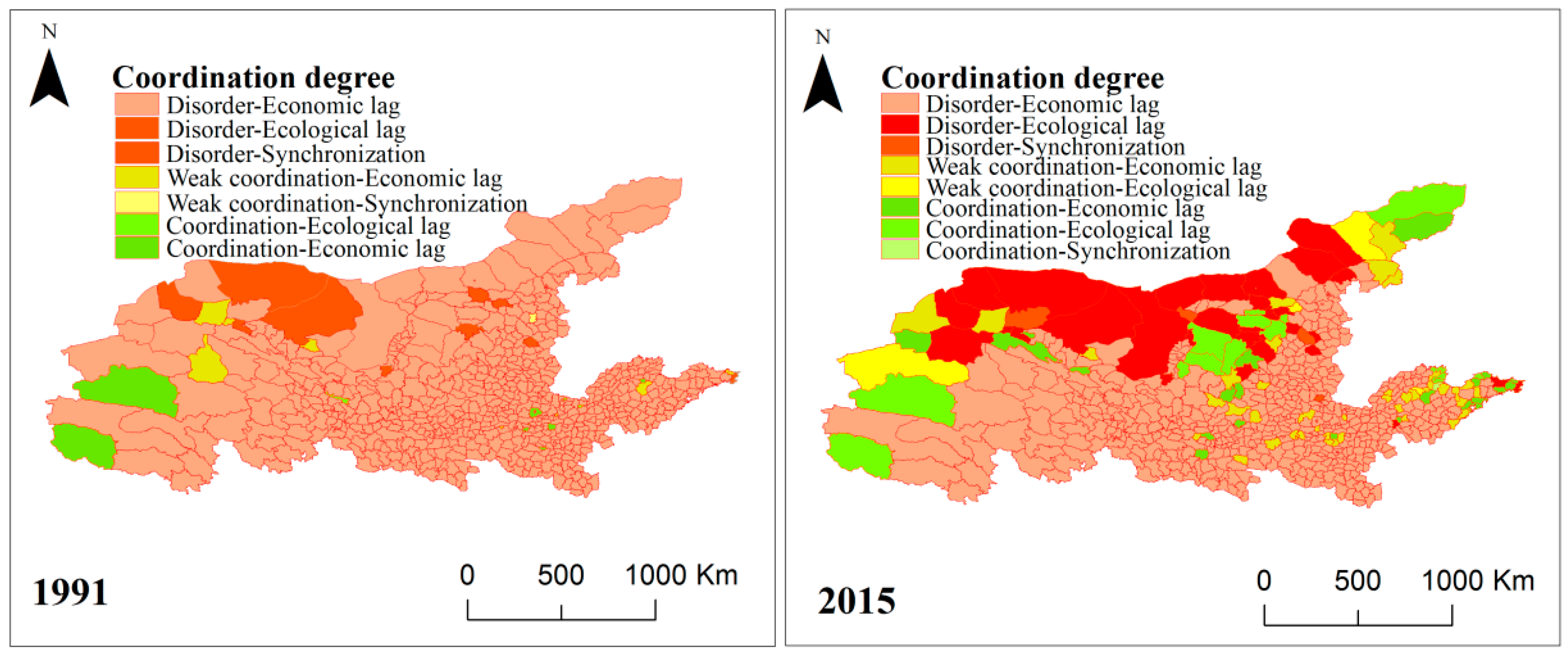
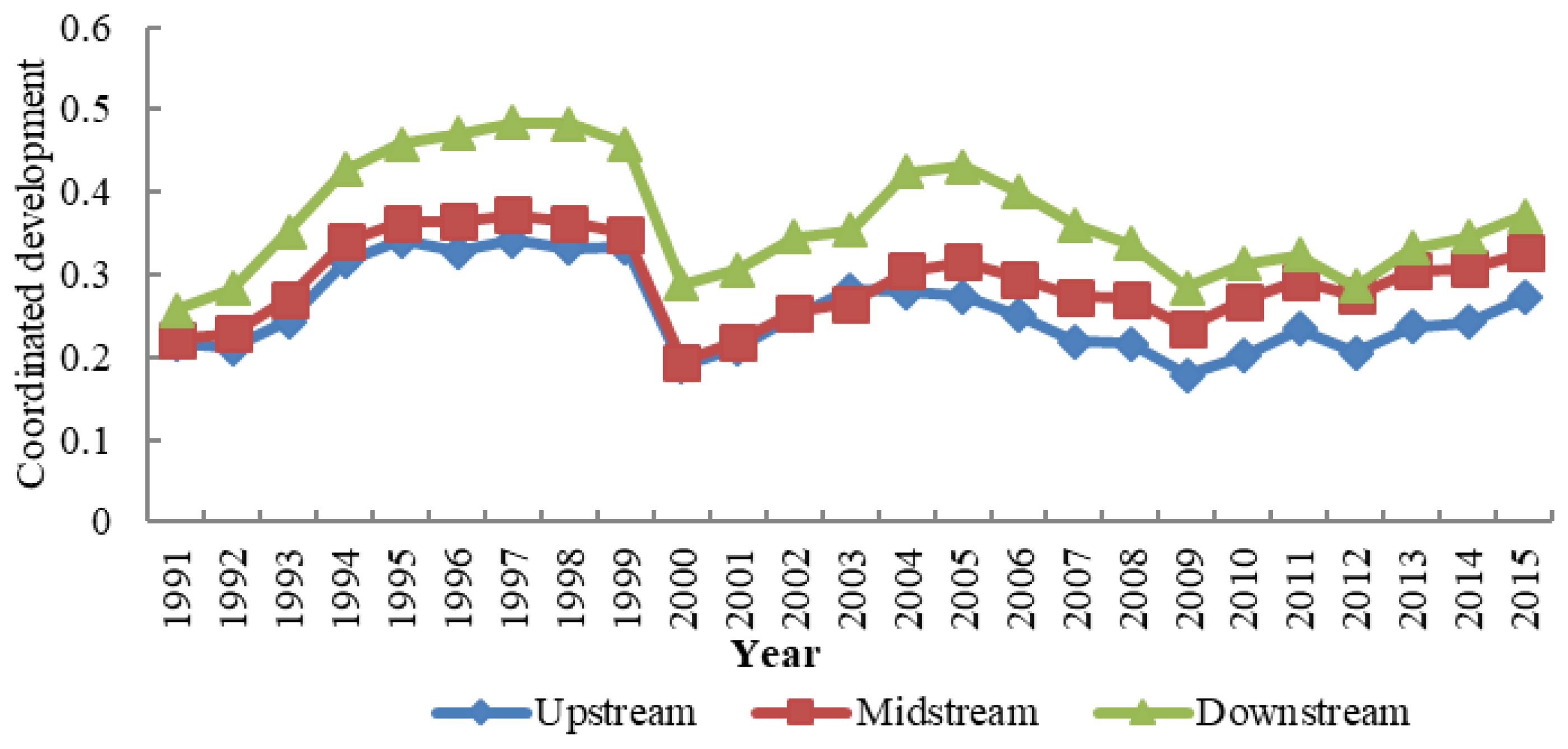
| ZoneType | ||
|---|---|---|
| Upstream key development zone | 0.59 | 0.41 |
| Upstream restricted development zone | 0.29 | 0.71 |
| Midstream key development zone | 0.77 | 0.23 |
| Middle restricted development zone | 0.41 | 0.59 |
| Downstream key development zone | 0.67 | 0.33 |
| Downstream restricted development zone | 0.37 | 0.63 |
| Downstream optimized development zone | 0.51 | 0.49 |
| Highest Values | Lowest Values | |||
|---|---|---|---|---|
| Ecological value (100 million Yuan) | Golmud | 624.15 | Xuchang City District | 0.94 |
| Zhiduo County | 378.13 | Yima City | 0.88 | |
| Dulan County | 289.41 | Jincheng City District | 0.87 | |
| Haixi Mongolian and Tibetan Autonomous Prefecture | 205.86 | Linxia City | 0.70 | |
| Maduo County | 199.21 | Ulanqab City District | 0.36 | |
| Ecological value per unit area (10,000 Yuan/km2) | Pingdingshan City District | 99.08 | Suzhou District | 7.01 |
| Mian County | 98.75 | Ejina Banner | 6.34 | |
| Tanghe County | 98.74 | Yijinhuoluo Banner | 6.30 | |
| Fangcheng County | 97.74 | Guyang County | 6.23 | |
| Ju County | 97.26 | Yuanping City | 5.07 | |
| Change State | Upstream | Midstream | Downstream | Total | |
|---|---|---|---|---|---|
| Rise | Disorder–Weak coordination | 3 | 17 | 28 | 48 |
| Disorder–Coordination | 6 | 15 | 13 | 34 | |
| Weak coordination–Coordination | 0 | 0 | 2 | 2 | |
| Fall | Coordination–Disorder | 1 | 1 | 5 | 7 |
| Coordination–Weak coordination | 0 | 0 | 0 | 0 | |
| Weak coordination–Disorder | 2 | 1 | 2 | 5 | |
| Total | 12 | 34 | 50 | 96 | |
Publisher’s Note: MDPI stays neutral with regard to jurisdictional claims in published maps and institutional affiliations. |
© 2021 by the authors. Licensee MDPI, Basel, Switzerland. This article is an open access article distributed under the terms and conditions of the Creative Commons Attribution (CC BY) license (http://creativecommons.org/licenses/by/4.0/).
Share and Cite
Zhang, Z.; Chang, T.; Qiao, X.; Yang, Y.; Guo, J.; Zhang, H. Eco-Economic Coordination Analysis of the Yellow River Basin in China: Insights from Major Function-Oriented Zoning. Sustainability 2021, 13, 2715. https://doi.org/10.3390/su13052715
Zhang Z, Chang T, Qiao X, Yang Y, Guo J, Zhang H. Eco-Economic Coordination Analysis of the Yellow River Basin in China: Insights from Major Function-Oriented Zoning. Sustainability. 2021; 13(5):2715. https://doi.org/10.3390/su13052715
Chicago/Turabian StyleZhang, Zhongwu, Tianying Chang, Xuning Qiao, Yongju Yang, Jing Guo, and Han Zhang. 2021. "Eco-Economic Coordination Analysis of the Yellow River Basin in China: Insights from Major Function-Oriented Zoning" Sustainability 13, no. 5: 2715. https://doi.org/10.3390/su13052715
APA StyleZhang, Z., Chang, T., Qiao, X., Yang, Y., Guo, J., & Zhang, H. (2021). Eco-Economic Coordination Analysis of the Yellow River Basin in China: Insights from Major Function-Oriented Zoning. Sustainability, 13(5), 2715. https://doi.org/10.3390/su13052715





